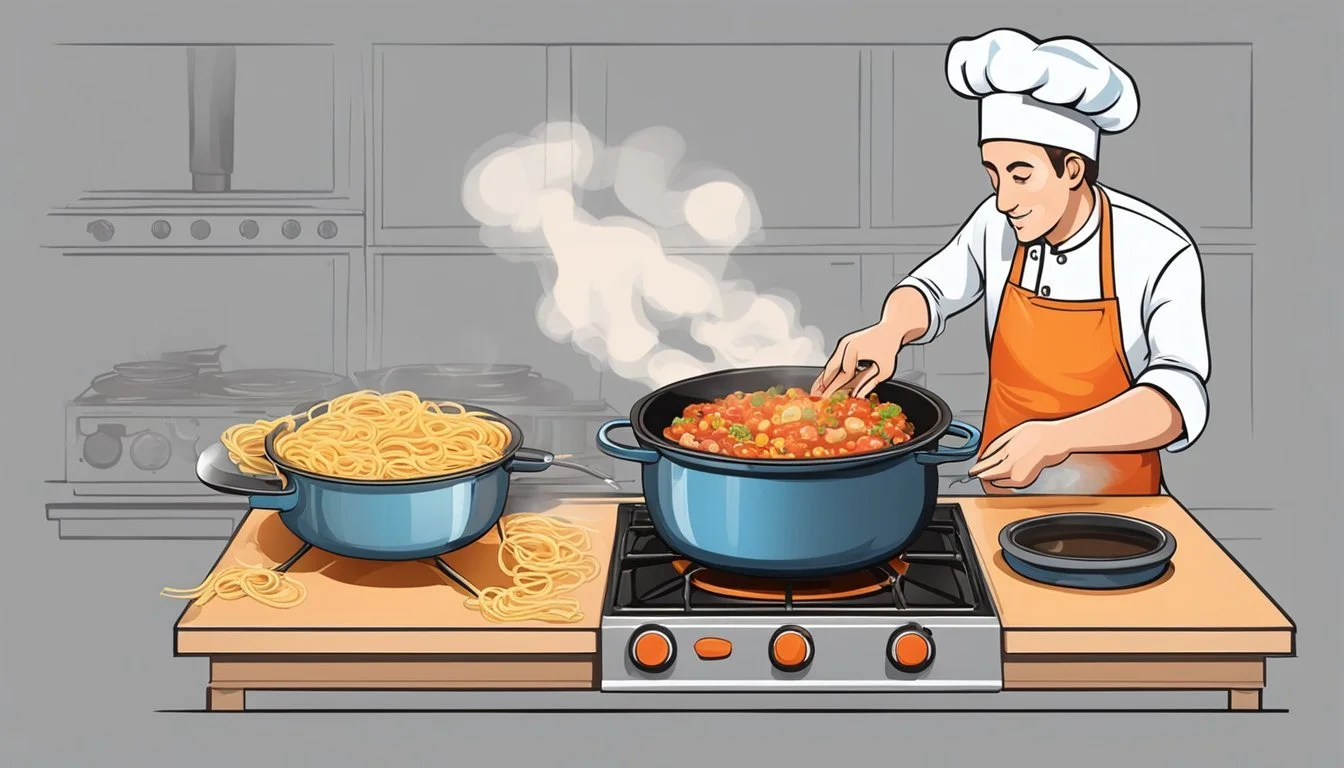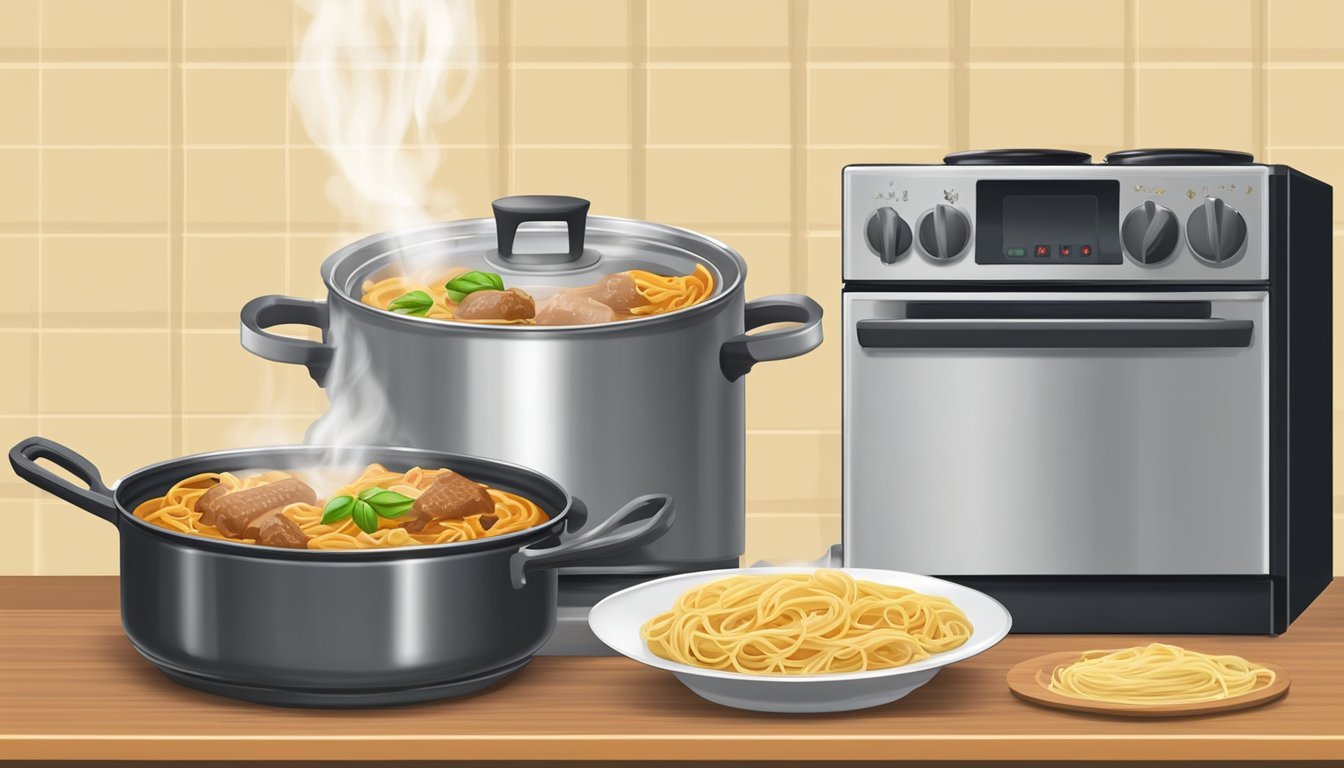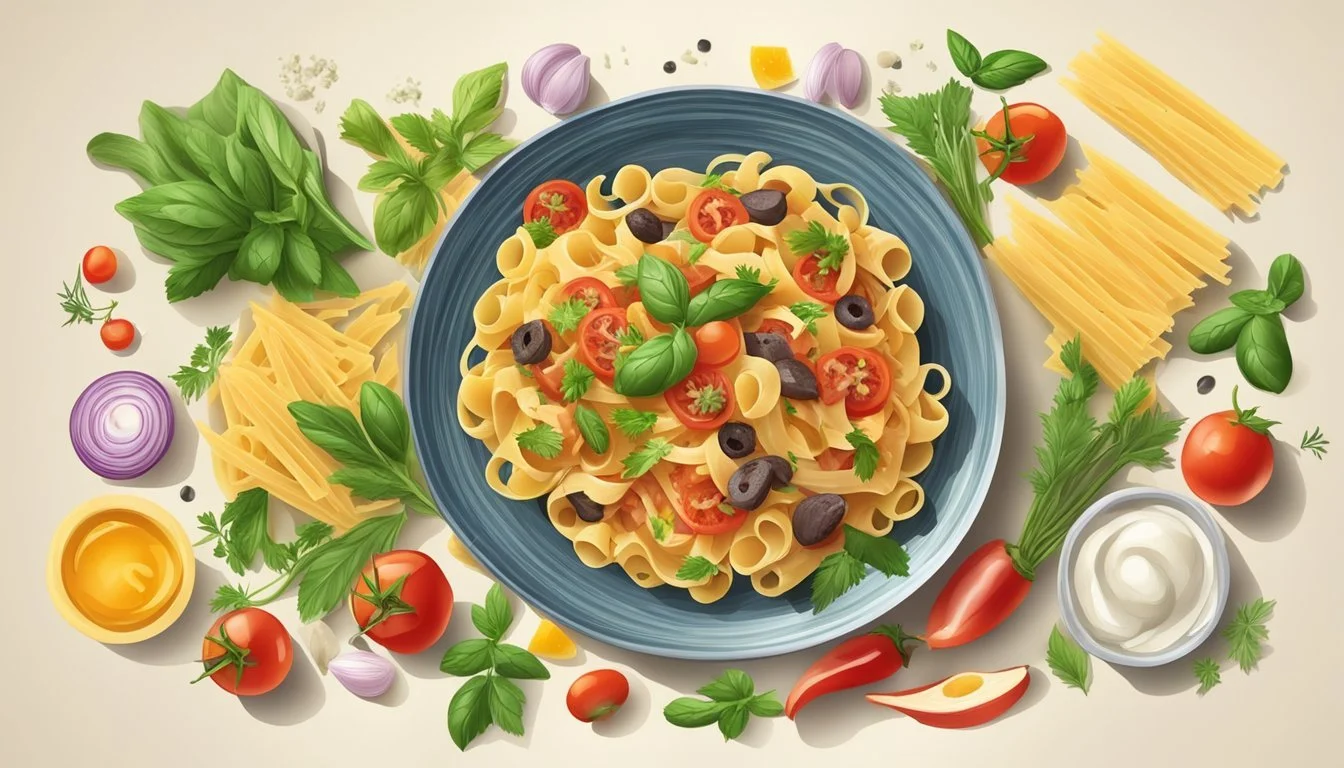How to Make Carnivore Pasta
A High-Protein Recipe Guide
Crafting delicious and nutritious meals can be challenging, especially when adhering to a strict carnivore diet. For those looking to enjoy classic pasta dishes without straying from an animal-based, low-carb regimen, carnivore pasta provides an excellent pasta alternative that fits seamlessly into your carnivore diet. These noodles, made primarily from ingredients like eggs, beef gelatin, and pork rinds, offer a rich source of protein while being entirely free of plant-based components.
With just a few simple steps, one can create these noodles at home, transforming them into any pasta dish they desire. Picture this: a hearty plate of carnivore fettuccine, topped with tender slices of beef or creamy Alfredo sauce, all while staying fully committed to animal-based nutrition. The beauty of carnivore pasta lies not only in its compatibility with the diet but also in its versatility and ease of preparation.
Embracing this pasta alternative can revolutionize meal planning for those on a carnivore diet. The simplicity of the recipe means it's a great option for busy individuals or those new to this way of eating. They won't miss out on their favorite dishes, all while enjoying the benefits of a carnivore lifestyle.
Understanding the Carnivore Diet
The carnivore diet is a high-protein, high-fat regimen focusing on animal-based foods. It eliminates carbohydrates, sugar, and fiber entirely, relying on meat, fish, and animal products for nutrition.
Principles of Carnivore Eating
The key principle of the carnivore diet is absolute reliance on animal-derived foods. Beef, pork, chicken, fish, and eggs form the backbone of this diet.
Dairy products like cheese and butter are also included by many adherents. Organ meats such as liver provide essential nutrients. No plant-based foods like vegetables, fruits, nuts, or grains are consumed. The focus is on maximizing protein and fat intake while eliminating carbohydrates completely. Sodium intake may increase due to high consumption of salted meat products.
Health Benefits and Nutritional Profile
Proponents of the carnivore diet claim numerous health benefits. These include weight loss, improved mental clarity, and reduced inflammation. The diet is rich in protein, total fat, saturated fat, and essential nutrients such as iron and cholesterol.
Unlike other diets, the carnivore diet completely avoids fiber and sugar. This absence is seen as beneficial by some who face digestive issues. Additionally, consuming net carbs becomes irrelevant since none are consumed. The high consumption of protein aids muscle growth and maintenance, making it popular among athletes.
Overall, the nutritional profile emphasizes high animal-based nutrient density.
Essential Ingredients for Carnivore Pasta
Creating delicious carnivore pasta requires a focus on high-quality proteins, suitable fat and dairy additions, and carnivore-friendly cheeses. These ingredients ensure that the pasta is both nutritious and fits perfectly within a carnivore diet.
Selecting Quality Meat
Meat forms the backbone of carnivore pasta. Choosing high-quality, fresh meat is crucial. Ground beef and pork are common choices, adding rich flavor and texture. Look for meat that has a good balance of fat to ensure the pasta remains moist and flavorful.
Key meats to consider:
Ground beef
Ground pork
Beef gelatin
Choosing Fat and Dairy Products
Fats and dairy products enhance flavor and consistency. Heavy cream adds richness, while cream cheese provides a smooth texture. When incorporating fat, consider using high-quality butter or pork rinds for added crunch and flavor.
Essential dairy products:
Heavy cream: Adds richness.
Cream cheese: Ensures a creamy texture.
Egg yolks: Provides structure and added fat.
Types of Carnivore-friendly Cheese
Cheese enriches the pasta with additional fat and protein. Parmesan cheese, both fresh and dry, is an excellent choice, offering a sharp and nutty flavor. Finely ground pork rinds can be used as a low-carb alternative to traditional breadcrumb toppings.
Recommended cheeses:
Parmesan cheese
Dry parmesan
Ground pork rinds
Each of these ingredients plays a vital role in making carnivore pasta both delicious and diet-friendly.
Preparing Your Kitchen
Before embarking on making carnivore pasta, it's crucial to ensure your kitchen is well-prepared with the right tools and following proper safety measures. This section provides detailed guidance on the essential equipment and safety precautions to take.
Tools and Equipment
Having the right tools and equipment on hand is vital for making carnivore pasta. Essential items include a blender for mixing ingredients into a smooth mixture and a sharp knife to cut the pasta into desired shapes.
A baking sheet with a silicone mat is recommended for baking the pasta, ensuring it doesn't stick and cooks evenly.
A spatula will be useful for spreading the mixture thinly on the mat. Other handy tools include a whisk for combining ingredients and parchment paper to aid in rolling out the pasta.
Additionally, a microwave and fridge are necessary for some recipes that require setting the mixture before baking. Ensuring you have these items ready will make the process smoother and more efficient.
Enjoy having blender, baking sheet, silicone mat, spatula, and whisk delivered right to your door when you buy it online!
Preheating and Safety Tips
Preheating your oven is a key step in preparing carnivore pasta. Set your oven to 350°F (175°C) to ensure it’s the right temperature when you’re ready to bake. A properly preheated oven helps achieve the perfect texture and cooking consistency.
Safety in the kitchen is paramount. Use oven mitts when handling the hot baking sheet to avoid burns. Ensure your working area is clean and clutter-free to prevent accidents.
Keep a fire extinguisher nearby in case of emergencies. Additionally, always use a sharp knife with caution. A sharper knife is safer than a dull one because it requires less force and is less likely to slip.
By preparing your kitchen with the correct tools and ensuring safety measures, you can focus on crafting delicious carnivore pasta with confidence.
Creating the Pasta Base
Carnivore pasta requires a simple, efficient approach to blend and shape the ingredients into delicious, low-carb noodles. Key components like eggs, beef gelatin, and egg whites are essential.
Mixing Ingredients
To begin, gather your ingredients: eggs, heavy cream, parmesan cheese, beef gelatin, and egg white powder.
Combine these ingredients in a blender or hand mixer. Start by whipping the eggs until they become frothy. Gradually incorporate the heavy cream and parmesan cheese, ensuring a smooth mixture. Add the beef gelatin, which acts as a stabilizing agent, providing the noodles with a firm texture. Finally, mix in the egg white powder, adding one tablespoon at a time until fully combined. This mixture sets the foundation for a sturdy pasta base.
Shaping the Noodles
Once the mixture is ready, pour it onto a silicone mat placed on a baking sheet. Use an angled spatula to spread the mixture thinly and evenly across the mat. Bake the mixture in a preheated oven at 350°F (175°C) for about 8-10 minutes, or until the pasta becomes pale and firm.
After baking, allow the pasta sheet to cool for approximately 15 minutes. When cool, peel it off the mat and roll it up like a jelly roll. Use a sharp knife to slice the roll into your desired noodle shape, such as fettuccine, linguine, or lasagna noodles. These noodles can be used in a variety of ketogenic and low-carb dishes, providing a versatile base for any meal.
Pasta Cooking Techniques
Two common methods for preparing carnivore pasta are baking pasta in the oven and boiling or simmering. Each method has its own benefits and specific steps to achieve the best texture and flavor, tailored for a low-carb, protein-rich diet.
Baking Pasta in the Oven
To make carnivore pasta using the baking method, preheat your oven to 350°F (175°C). Start by preparing the pasta mixture using ingredients like parmesan cheese and egg white powder. Once well mixed, pour the mixture onto a baking sheet lined with parchment paper or a silicone mat.
Spread the mixture thin and evenly using an angled spatula. Bake the pasta in the oven for about 8-10 minutes until it is set and the edges begin to brown. After baking, allow the pasta to cool for around 15-30 minutes until it is cold and sturdy. Once cooled, use a knife to cut the pasta into strips of desired thickness.
Boiling and Simmering
While baking is popular, boiling and simmering carnivore pasta can also be effective. This method often starts with a similar mixture of protein-rich ingredients. Once the mixture is prepared, form it into pasta shapes such as fettuccine.
Boil a pot of salted water and add the pasta shapes to the boiling water. Simmer gently to cook the pasta until it firms up, usually for a few minutes. Be cautious, as overcooking can lead to a mushy texture. This method is quicker and often used when time is of the essence.
Homemade Sauces and Toppings
Elevate your carnivore pasta with a range of homemade sauces and toppings designed to complement the richness of the dish. From meat-based sauces to creamy cheese options, there's a perfect sauce for every preference. Additionally, incorporating specific herbs and seasonings can enhance the flavor profile without compromising the carnivore diet.
Creating a Meat-based Sauce
A meat-based sauce adds depth and heartiness to carnivore pasta. For a classic option, brown ground beef, pork, or a mix of both in a skillet. Add bone broth for richness and simmer until thickened. Lamb or veal can also be used for varied flavors.
To further enhance the sauce, incorporate pancetta or bacon for a smoky undertone. If desired, simmering the sauce with sage can introduce a subtle earthiness. Use these hearty sauces immediately or freeze in portions for later use.
Carnivore Cheese Sauces
Cheese sauces, like Alfredo, add a creamy texture to the pasta. To prepare a simple Alfredo, melt butter in a pan, then add heavy cream and simmer. Stir in grated parmesan cheese until the sauce thickens. No additional thickeners are necessary as the cheese will provide the desired consistency.
For a richer sauce, use mascarpone or cream cheese. These blend seamlessly with melted parmesan for a velvety finish. Adjust seasoning with salt and white pepper. Store leftovers in an airtight container for up to a week, or freeze for longer preservation.
Herbs and Seasonings
While the carnivore diet is restrictive with vegetables and herbs, certain low-carb seasonings can be included. Italian seasoning blends like oregano, basil, and rosemary offer an herbal aroma without adding carbs. Use sparingly to avoid overpowering the dish.
Another option is fresh or dried sage, which brings a milder flavor perfect for meat-based dishes. A small amount of black or white pepper can be used to add spice. Ensure any seasonings used are free from added sugars or fillers to stay true to the diet.
Serving Suggestions
Carnivore pasta can be versatile and complements many meat-based dishes. It also works perfectly when incorporated into soups, providing a hearty and satisfying meal.
Pairing with Meat Dishes
Carnivore pasta pairs excellently with meat dishes such as spaghetti and meatballs, grilled steaks, or braised short ribs. The pasta’s neutral flavor absorbs rich, savory sauces well, enhancing the meat's taste.
Use a thick and creamy Alfredo sauce or a robust marinara sauce to elevate your meal. For a classic touch, coat the pasta in a Bolognese sauce, intertwining the noodles with ground beef or pork. Leftovers can also be revitalized by pairing them with roasted chicken or pork chops.
This pasta can complement a variety of textures and flavors in meat dishes, making it a flexible addition to any meal plan.
Incorporating into Soups
Carnivore pasta can transform a simple soup into a filling meal. It’s an ideal addition to chicken noodle soup, providing extra protein and thickness. Cut the pasta into thin, 1/4-inch strips or wider fettuccine for a different texture.
Add the pre-cooked pasta to the soup just before serving to prevent overcooking. It blends well with beef broth-based soups and can enhance hearty vegetable beef soup. For a twist, try a creamy pumpkin or tomato soup mixed with carnivore pasta, creating a delicious and unique meal.
By incorporating carnivore pasta into various soups, they gain more substance and nutritional value, making them more satisfying.
Storing and Reheating
Proper storage and careful reheating can ensure that carnivore pasta retains its texture and flavor. Follow the guidelines provided to maintain the integrity of your dish.
Best Practices for Storage
Leftovers should be stored in an airtight container to prevent drying out in the fridge. Ensure the pasta is completely cool before sealing it. This helps to retain moisture and prevents bacterial growth.
Using glass or BPA-free plastic containers is recommended for optimal food safety. Label the containers with the date to keep track of freshness. Carnivore pasta can generally last in the fridge for up to 3-4 days.
For longer storage, consider freezing. Ensure the pasta is packed in a freezer-safe container and can be frozen for up to 2 months. Thaw frozen pasta in the fridge overnight before reheating.
Reheating for Optimal Taste
When reheating carnivore pasta, methods like microwaving or using an oven can be effective. For the microwave, place pasta in a microwave-safe bowl and add a tablespoon of water or broth to retain moisture. Cover with a lid or plate and heat in short intervals, stirring between each to ensure even warming.
Using an oven can enhance the texture. Preheat the oven to 300°F (150°C). Place the pasta in an oven-safe dish, cover with aluminum foil, and heat for 10-15 minutes. This method helps in evenly heating without making the pasta rubbery.
Avoid overcooking, as it can affect the texture and taste, diminishing the nutritional benefits. Implementing these reheating methods can result in a meal that tastes almost as good as freshly made.
Presentation and Garnishing Tips
A visually appealing plate enhances the dining experience. To create a beautiful presentation, start with a plate-as-canvas approach. Place the main food item, the carnivore pasta, at the center.
Use space wisely: Avoid overcrowding. Balance the arrangement with enough space between elements.
Balance colors and textures: Add grated parmesan to the top for a touch of elegance. The white flakes will contrast with the darker pasta.
Vary heights: Create visual interest by stacking or layering elements. This adds depth and dimension to the plate.
Sauces and drizzling: Use a spoon or squeeze bottle to drizzle sauces artfully around the pasta. It enhances both flavor and appearance.
Garnishing ideas:
Fresh herbs: A sprinkle of finely chopped parsley or basil.
Cheese: Grated parmesan adds a classic touch.
Meat toppings: Thin slices of crispy bacon or other meat can enhance both look and taste.
Remember, a well-presented dish not only looks appealing but also invites the diner to savor the carefully crafted flavors.
Additional Resources
For those interested in exploring more about carnivore pasta, there are numerous online resources dedicated to recipes and related products.
Carnivore Cooking Blogs
Several notable blogs provide detailed recipes for making carnivore pasta. Ketogenic Woman and KetoAndEat are well-regarded for their thorough recipe cards, offering step-by-step instructions and high-quality photos. Low-Carb, So Simple! also features easy-to-follow recipes with tips on baking and cooling techniques.
Pinterest boards focusing on carnivore diets often feature pins from these blogs, making it easy to save and organize your favorite recipes. Most blogs also offer the ability to print the recipe card directly from the site, ensuring easy access while cooking.
Related Products and Reviews
When preparing carnivore pasta, certain kitchen tools and ingredients can enhance the experience. Silicone mats and angled spatulas are frequently recommended for spreading and baking the pasta mixture evenly. Amazon Associate links on various blogs often guide visitors to these products.
Reviews for items like beef gelatin, pork rinds, and egg white powder can also be found, helping users select high-quality ingredients. Product reviews are available through blog comment sections as well as dedicated review sites, providing insights from other home cooks.











